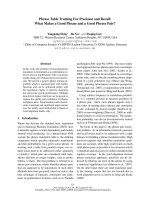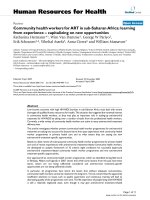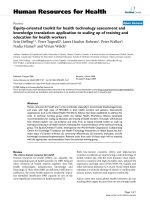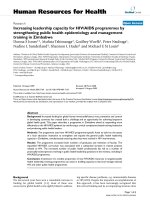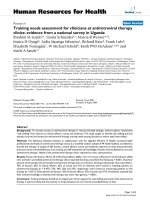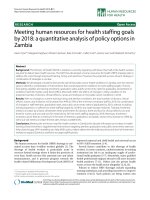Báo cáo sinh học: " Optimum truncation points for independent culling level selection on a multivariate normal distribution, with an application to dairy cattle selection" pot
Bạn đang xem bản rút gọn của tài liệu. Xem và tải ngay bản đầy đủ của tài liệu tại đây (619.5 KB, 14 trang )
Original
article
Optimum
truncation
points
for
independent
culling
level
selection
on
a
multivariate
normal
distribution,
with
an
application
to
dairy
cattle
selection
V.
Ducrocq
J.J. Colleau
Institut
National
de
la
Recherche
Agronomique,
Station
de
Génétique
Quantitative
et
Appliquée,
Centre
de
Recherches
de
Jouy-en-Josas,
78350
Jouy-en-Josas,
France
(received
1
March
1988,
accepted
19
September
1988)
Summary —
Independent
culling
level
selection
is
often
practiced
in
breeding
programs
because
extreme
animals
for
some
particular
traits
are
rejected
by
breeders
or
because
records
on
which
genetic
evaluation
is
based
are
collected
sequentially.
Optimizing
these
selection
procedures
for
a
given
overall
breeding
objective
is
equivalent
to
finding
the
combination
of
truncation
thresholds
or
culling
levels
which
maximizes
the
expected
value
of
the
overall
genetic
value
for
selected
animals.
A
general
Newton-type
algorithm
has
been
derived
to
perform
this
maximization
for
any
number
of
normally
distributed
traits
and
when
the
overall
probability
of
being
selected
is
fixed.
Using
a
power-
ful
method
for
the
computation
of
multivariate
normal
probability
integrals,
it
has
been
possible
to
undertake
the
numerical
calculation
of
the
optimal
truncation
points
when
up
to
6
correlated
traits
or
stages
of
selection
are
considered
simultaneously.
The
extension
of
this
algorithm
to
the
more com-
plex
situation
of
maximizing
annual
genetic
response
subject
to
nonlinear
constraints
is
demonstra-
ted
using
a
dairy
cattle
model
involving
milk
production
and
a
secondary
trait
such
as
type.
Conside-
ration
is
given
to
three
of
the
four
pathways
of
selection:
dams
of
bulls;
sires
of
bulls;
and
sires
of
cows.
Independent
culling
level
selection -
dairy
cattle -
multistage
selection -
genetic
galn -
multivariate
normal
distrlbution
Résumé —
Seuils
de
troncature
optimaux
lors
d’une
sélection
à
niveaux
Indépendants
sur
une
distribution
multlnormale,
avec
une
application
à
la
sélection
chez
les
bovins
laitiers.
Une
sélection
à
niveaux
indépendants
est
souvent
pratiquée
dans
les
programmes
génétiques,
parce
que
les
animaux
extrèmes
pour
certains
caractères
sont
rejetés,
ou
parce
que
les
données
qui
servent
à
l’évaluation
génétique
des
animaux
sont
recueillies
séquentiellement.
L’optimisation,
pour
un
objectif
donné,
de
ces
règles
de
sélection
équivaut
à la
recherche
des
seuils
de
troncature
qui
maximisent
l’espérance
de
I objectif
de
sélection
pour
les
animaux
retenus.
Un
algorithme
géné-
ral
de
type
Newton
est
établi
pour
effectuer
cette
maximisation
pour
un
nombre
quelconque
de
caractères
distribués
selon
une
loi
mulünormale
et
lorsque
la
probabilité
finale
d’être
retenu
est
bxée. A
partir
d’une
méthode
puissante
de
calcul
d’intégrales
de
lois
multinormales,
il
a
été
possible
d’entreprendre
numériquement
le
calcul
des
seuils
de
troncature
quand
jusqu’à
6
caractères
ou
étapes
de
sélection
corrélés
sont
considérés
simultanément.
L’extension
de
cet
algorithme
à
des
situations
plus
complexes,
comme
la
maximisation
du
progrès
génétique
annuel
sous
plusieurs
contraintes
non
linéaires,
est
illustrée
à
travers
le
calcul
de
règles
optimales
de
sélection
des
mères
à
taureau,
pères
à
taureau
et
pères
de
service
pour
la
production
laitière
et
pour
un
caractère
secondaire
tel
que
le
pointage
laitier
dans
un
schéma
de
sélection
typique
des
bovins
laitiers.
sélection
à
niveaux
Indépendants -
bovins
laltlers -
sélectlon
par
étapes -
progrès
génétique -
distribution
multlnormsle
Introduction
It
is
often
possible
to
describe
selection
objectives
through
linear
combinations -
aggre-
gate
genotype -
of
breeding
values
on
several
(m)
traits.
Then
the
optimal
selection
pro-
cedure
consists
of
using
a
selection
index
which
combines
observed
values
for
several
(n)
sources
of
information
(Hazel
and
Lush,
1942).
However,
this
approach
is
occasionally
not
used
for
two
main
reasons:
a)
Practitioners
sometimes
emphasize
the
need
to
cull
extreme
animals
(deviants
for
some
traits)
because
they
are
deemed
undesirable.
Then,
the
selection
objective
is
impli-
citly
recognized
as
being
nonlinear.
The
cost
of
such
a
practice
with
respect
to
a
strict
application
of
the
optimal
linear
index
may
not
be
justifiable
when
this
nonlinearity
is
unimportant
or
questionable.
b)
The
records
required
to
compute
the
selection
index
are
not
always
available
simul-
taneously
and/or
their
cost
does
not
justify
their
collection
for
all
the
candidates
for
selec-
tion.
Therefore
selection
schemes
involve
different
stages
which
correspond
to
trunca-
tions
on
the
joint
distribution
of
all
possible
records.
Within
these
constraints,
it
is
potentially
interesting
to
evaluate
and
improve
the
effi-
ciency
of
practical
selection
procedures
by
determining
optimal
conditions
of
application
of
independent
culling
level
selection.
As
far
as
we
know,
the
published
works
on
this
topic
have
been
greatly
limited
by
the
number
of
variables
considered.
Generally
speaking,
studies
on
the
algebraic
derivation
of
optimum
truncation
thresholds
with
cor-
responding
numerical
computation
have
dealt
with
no
more
than
2
variables
(Namkoong,
1970;
Evans,
1980;
Cotterill
and
James,
1981;
Smith
and
Quaas,
1982).
Recently,
Ducrocq
and
Colleau
(1986)
treated
examples
with
3
variables
to
illustrate
potential
uses
of
a
numerical
method
to
compute
multivariate
normal
probabilities.
In
practice,
though,
the
number
of
traits
or
selection
stages
involved
may
be
significantly
larger.
Moreover,
the
algorithms
previously
considered
have
been
specifically
developed
for
a
given
num-
ber
n
of
variables
and
their
extension
to
any
n
is
not
obvious
though
algebraic
conditions
which
must
be
verified
at
the
optimum
have
been
reported
(Jain
and
Amble,
1962;
Smith
and
Quaas, 1982).
Indeed,
as
a
consequence
of
the
limitation
of
the
number
of
variables
considered,
the
optimization
problem
has
been
restricted
to
rather
simple
types
of
objective
functions,
which
may
not
adequately
summarize
the
overall
efficiency
of
selection
schemes.
In
par-
ticular,
authors
have
not
considered
functions
such
as
the
annual
genetic
gain
of
the
selection
objective -
computed
using
Rendel
and
Robertson’s
(1950)
formula -
in
rela-
tively
complex
situations
(e.g.
involving
the
4
paths
of
transmission
of
genetic
progress).
This
paper
presents
basic
yet
general,
i.e.
for
any
n
algorithms
which
can
be
used
for
the
computation
of
optimal
truncation
points
for
a
broad
class
of
objective
functions
with
one
or
more
constraints.
Theory
is
developed
and
applications
are
presented
for
the
general
multivariate
problem
considered
by
Smith
and
Quaas
(1982).
A
practical
example
of
application
in
the
dairy
cattle
context
is
described.
Corresponding
numerical
results
are
given.
Solution
of
Smith
and
Quaas’
problem
in
the
general
case
Statement
of
the
problem
Let
u,
xl,
x,,
be
n+1
random
variables
with
joint
multivariate
normal
distribution:
u
is
the
breeding
objective
and
the
xis
are
the
observed
variables.
The
problem
is
to
find
cl,
C2
&dquo;&dquo;
Cn
so
as
to
maximize
Ep
(u)
subject
to:
where
P
is
given
and
represents
the
overall
fraction
of
candidates
selected.
Notations
Let
!&dquo;
(x;
Rn)
be
the
standard
multivariate
normal
density
of
dimension
n
with
variance
covariance
matrix
Rn.
Let
We
need
the
following
recursive
definitions
for
distributions
conditioned
on
q::;;n-1
variates.
Solution
Using
the
general
result
of
Jain
and
Amble
(1962)
we
have:
Since
Q(c
1
,
cn)
is
to
be
equal
to
a
constant
P,
the
maximization
of
Ep
(u)
is
tanta-
mount
to
the
maximization
of
N(c
l
, ,
cn
).
The
constraint
Q(c,,
cn)
=
P
is
incorporated
using
the
method
of
Lagrange
multipliers
(Bass,
1961,
p.
928;
Smith
and
Quaas,
1982):
the
optimal
truncation
points
are
those
for
which
the
partial
derivatives
of
the
function
f
(w)
=
N(c
1’
&dquo;
en)
+
X(Q(c,
cn
) -
P)
with
respect
to
w’=
(
C1’
&dquo;
’’
cn,
X)
are
0.
Â.
is
called
a
Lagrange
multiplier.
The
resulting
system
of
nonlinear
equations
in
w’
= (C1’
cn.
X)
is
solved
iteratively
using
the
multidimensional
Newton’s
method
(Dennis
and
Schnabel,
1983).
Denote
as
wct>
the
approximate
solution
at
iteration
t
(w(o)
is
a
given
starting
value).
A
better
estimate
w(t+
1
)is
computed
from:
The
final
solution
wIt)
=
w*
is
obtained
when
is
sufficiently
small,
where
I I
h
I I denotes
any
norm.
As
long
as
the
starting
value
w(o)
is
not
too
far
from
w*
(generally,
w(o)
=
0
seems
to
be
a
robust
initial
value),
convergence
is
very
fast
(quadratic
convergence:
Dennis
and
Schnabel,
1983).
c*
is
a
local
maximum
for
E
(u),
provided
’
is
positive
definite,
but
nothing
guarantees
that
w*
is
a
global
maximum
for
f
(w).
Now,
note
that:
So
we
can
write:
where:
Another
method
exists
for
the
derivation
of
these
expressions,
first
reasoning
on
deri-
vatives
of
integrals
and
then
using
Jain
and
Amble’s
(1962)
formula
on
conditional
distri-
butions.
This
leads
to
more
compact
expressions
but
may
be
less
flexible
for
considera-
tions
on
several
u
(general
problem
with
several
constraints
on
several
objectives)
(see
Appendix).
Expressions
(3)
to
(11)
include
all
the
elements
required
for
the
computation
of
the
vector
8f(w)/Bw
and
the
matrix
(8
2
f(w)/Bw
Sw
*)
in
(1).
In
particular,
It
can
be
observed
that
the
equations
(6f(w)/6c
i)
=
0
in
(12)
for
1 !i!n
are
linear
in
X.
The
size
of
the
system
of
equations
to
be
solved
can
be
easily
reduced
by
absorption
of
the
Lagrange
multiplier.
For
example,
we
have:
is equivalent to:
Derivatives
with
respect
to
the
cis
of
the
equations
in
(17)
are
required
for
the
applica-
tion
of
Newton’s
method
as
in
(2).
They
are
readily
derived
using
(6)
to
(8).
Numerical
applications
Studies
on
independent
culling
level
selection
have
been
mainly
limited
to
2-trait
selec-
tion
probably
because
general
and
efficient
programs
to
compute
the
multivariate
normal
probability
integrals
in
Jain
and
Amble’s
formula
were
not
available
for
dimensions >
2.
However,
easily
programmable
algorithms
exist.
In
particular,
Dutt
(1973, 1975)
and
Dutt
and
Soms
(1976)
proposed
a
general
method
characterized
by
good
precision
when
cor-
relation
coefficients
and
truncation
points
are
not
too
extreme.
For
more
details
on
this
method,
its
precision
and
computation
times,
see
Ducrocq
and
Colleau
(1986).
Dutt’s
.
technique
is
well
suited
for
numerical
applications
of
the
optimization
algorithm
presented
in
this
paper
when
up
to
6
selection
stages
or
traits
are
considered.
In
this
particular
case,
expressions
(7)
to
(11)
are
simpler,
since
Q
jj
=
1
and
Q
ijk
=
0.
Algebraic
and
numerical
results
are
equivalent
to
those
given
by
Smith
and
Quaas
(1982).
In
(9),
Q;ik
=
1.
The
algorithm
described
here
leads
to
the
same
results
as
those
pre-
sented
in
Ducrocq
and
Colleau
(1986).
3) . n = 4 to 6.
Consider
for
example,
n
traits
with
r;
i
=
(-1
(j/20i)
for
1 <_i<_j<_n
and
with
economic
weight
mi
=
1+i/20
1!i!n.
Table
I presents
the
truncation
points
qs
on
these
traits
which
maximize
Ep
(u
I c1,
c&dquo;)
when
the
overall
selected
fraction
is
P
=
0.25,
0.025,
0.001.
At
iteration
0,
the
cis
were
taken
equal
to
0.
The
stopping
criterion
for
the
Newton’s
iteration
was:
where
Ei
was
the
i th
left
hand
side
of
system
(17).
Convergence
was
fast
and
depended
on
how
far
the
initial
value
of
the
truncation
points
was
from
the
solution.
Note,
however,
that
in
the
examples
presented
in
Table
I,
correlations
between
variables
are
not
very
high
Q
r;! !
1 S
0.3)
and
the
weights
of
the
diffe-
rent
traits
are
of
the
same
magnitude.
When
this
is
not
the
case,
the
optimal
selection
procedure
may
involve
no
selection
at
all
on
one
or
several
of
these
traits.
The
same
observation
applies
to
small
overall
selection
intensity
(Young,
1961;
Namkoong,
1970;
Smith
and
Quaas,
1982;
Tibau
I
Font
and
Ollivier,
1984;
Ducrocq
and
Colleau,
1986).
In
limiting
cases
(with
very
low
or
very
high
selection
intensity
on
one
or
several
traits
or
when
correlations
are
extreme),
it
should
be
remembered
that
the
precision
of
Dutt’s
algorithm
for
computation
of
multivariate
probability
integrals
may
be
unsatisfactory
(Ducrocq
and
Colleau,
1986).
Then
alternative
methods
may
have
to
be
used
(e.g.,
Rus-
sell
et
al.,
1985).
An
application
in
the
dairy
cattle
context
Assumptions
Dairy
cattle
selection
is
performed
through
a
sequence
of
stages
which
characterizes
the
transition
from
one
generation
(g)
to
the
next
(g+1 ).
In
the
additive
polygenic
situation
which
is
assumed
for
most
of
the
traits
selected
in
domestic
animals,
it
is
possible
to
describe
these
stages
through
truncation
selection
procedures
on
different
variables
(e.g.,
Smith
and
Hammond,
1987).
These
first
include
selection
criteria
corresponding
to
the
transition
between
genera-
tions
g
and
g+1
(reproductive
stage),
followed
in
the
course
of
time
by
those
criteria
used
during
generation
g+1,
before
the
next
reproductive
cycle.
Our
approach
for
the
optimiza-
tion
of
these
successive
selection
stages
relies
on
the
assumption
of
multivariate
norma-
lity
for
these
2
criteria
when
candidates
for
selection
are
born.
Such
an
assumption
is
plausible
in
the
additive
polygenic
context,
especially
when
heritability
values
are
low
(Bulmer,
1980,
p.
154;
see
also
Smith
and
Hammond,
1987,
for
a
discussion
on
this
point).
A
more
strident
assumption
is
that
the
dispersion
parameters
of
the
joint
multiva-
riate
distribution
remain
constant
through
the
different
selection
cycles.
Breeding
objective
and
selection
stages
Assume
that
the
selection
objective
in
a
dairy
cattle
breed
is
a
linear
combination
of
2
traits:
&dquo;milk
production&dquo;
and
a
secondary
trait
such
as
&dquo;type&dquo;
(both
of
these
traits
may
be
themselves
linear
combinations
of
more
specific
characters).
A
possible
sequence
of
selection
stages
which
approximates
what
is
often
done
in
practice
is
the
following
(Figure
1):
1)
Dams
of
bulls
(DB)
of
generation
g
are
selected
based
on
their
estimated
breeding
values
X1
(for
milk)
and
X2
(for
type),
with
respective
thresholds
C1
and
c2
on
the
standar-
dized
variables.
These
dams
of
bulls
are
mated
to
sires
of
bulls
(SB)
of
generation
g.
2)
The
sons
of
these
cows
are
progeny
tested.
Sires
of
cows
(SC)
and
sires
of
bulls
of
generation
g+1
are
then
selected
according
to
their
estimated
breeding
values
x3
(for
milk)
and
X4
(for
type).
Truncation
thresholds
on
these
2
variables
are
different
for
SC
and
SB
(c
3,
c4
and
c5
c6,
respectively).
Selection
of
DB
can
be
modelled
as
if
it
were
performed
at
birth
of
the
male
calves.
This
is
essential
in
order
to
be
able
to
invoke
the
restoring
of
multivariate
normality
at
each
generation.
Let
RP
be
the
registered
(with
known
pedigree)
and
recorded
popula-
tion
of
cows
and
let
y
denote
the
proportion
of
these
cows
which
can
be
potential
dams
of
bulls
(e.g.
!y=
0.53
if
Al
sons
are
selected
from
cows
with
at
least
2
known
lactations).
If
it
is
assumed
(as
in
Ducrocq,
1984)
that
an
average
of
nd
=
6
potential
dams
must
be
selected
in
order
to
obtain
one
male
calf
entering
progeny
test,
it
can
be
considered
that
DB
selection
is
performed
by
truncation
on
the
estimated
breeding
values
x,
and
X2
of
the
dams
of
nb
=
(y
RP)/n
d
male
calves.
The
expression
of
the
annual
genetic
gain
given
by
Rendel
and
Robertson
(1950)
is:
Selection
on
the
dam
of
cow
path
is
ignored
(I!
=
0).
where
do
is
the
fraction
of
the
whole
population
bred
to
young
sires
(do
=
Ty
RP/T),
i.e.:
Constraints
Three
constraints
are
added
here:
1)
The
fraction
Ty
of
the
population
bred
to
young
sires
is
considered
as
constant,
since
in
practice
this
is
usually
the
limiting
factor
for
the
extension
of
progeny
test.
In
this
example,
the
number
of
recorded
daughters
per
young
sire
nvy
is
also
assumed
constant:
then,
the
number
ny
of
young
sires
progeny-tested
each
year
is
fixed,
as
well
as
their
repeatablity.
2)
The number
of
sires
of
cows
selected
each
year
is
determined
by
the
number
of
cows
(=
(T-RP)
+
(1-Ty)
RP)
to
be
bred
to
proven
sires
in
the
whole
population
(T)
and
the
total
number
of
doses
produced
by
a
given
sire
during
his
lifetime
(AI).
-
-
, ,
3)
The
number
of
sires
of
bulls
retained
each
year
is
constrained
to
be
equal
to
n
sB
,
the
number
below
which
problems
of
inbreeding
and
reduction
of
genetic
variability
are
feared.
Numerical
methods
and
results
When
constraints
(22),
(23)
and
(24)
are
satisfied,
equations
(18)
to
(21)
lead
to
the
follo-
wing
result:
where
L,
the
sum
of
the
generation
intervals
over
the
4
paths,
is
a
constant
in
our
case.
The
combination
of
truncation
points
c;,
i=1,
6
which
maximizes
(25)
with
the
constraints
(22),
(23)
and
(24)
is
obtained
by
equating
to
0
the
derivatives
of
f
(w)
with
respect
to
w’
=
(c
l
, c,,
X,
/.1,
v)
where:
and
X,
p,
v
are
Lagrange
multipliers.
The
first
and
second
derivatives
of
f
(w)
are
readily
obtained
using
the
general
formu-
lae
given
in
the
preceding
sections.
The
3
Lagrange
multipliers
are
eliminated
through
tri-
vial
absorption.
The
nonlinear
system
to
solve
then
involves
6
unknowns:
the
6
trunca-
tion
thresholds.
Solutions
obtained
using
Newton’s
method
are
presented
in
Table
III,
where
parameters
take
the
values
given
in
Table
II.
The
stopping
criterion
for
the
New-
ton’s
iterations
was:
.
where
Ei*
was
the
ith left
hand
side
of
the
absorbed
system
of
equations.
Convergence
was
fast -
always
less
than
8
iterations -
as
long
as
the
starting
value
c
(0)
of
c
=
{c
;
a’,6
was
not
too
far
from
the
solution.
In
contrast
with
the
numerical
results
presented
in
Table
I,
c
!o!
=
0
does
not
lead
to
convergence,
because
the
values
of
c
in
the
next
iterates
are
found
to
be
extremely
large
or
low;
i.e.,
totally
unrealistic
and
in
regions
where
the
precision
of
Dutt’s
method
is
not
good.
This
behavior
is,
at
least
indi-
rectly,
a
consequence
of
the
very
large
selection
intensity
of
proven
sires.
To
avoid
this
situation,
more
realistic
starting
values
must
be
chosen.
For
example,
c
(0)
can
be
com-
puted
as
the
truncation
points
for
which
the
conditions
(22),
(23)
and
(24)
are
satisfied
with
a
given
distribution
of
selection
efforts
between
milk
and
type,
i.e.,
c
(0)
is
such
that
Q
(c!O)
=
d,/a,
Q
(c,co!!
c!<0»
=
d!!
Q
(c,tot,
c!<o>,
C3
(o))
=
d2
la,
etc
for
some
a.
In
most
cases
presented
in
Table
III,
a
=
0.75.
For
strongly
unbalanced
weights
for
the
2
traits
(5:1),
convergence
is
obtained
only
for
even
larger
values
of
a
(e.g.,
a
=
0.99).
It
should
be
noted
that
selection
on
type
was
considered
posterior
to
selection
on
milk
production.
This
assumption
has
been
chosen
because
this
corresponds
to
what
is
done
in
practice
for
dams
of
bulls
in
France:
only
the
best
cows
for
milk
production
are
evalua-
ted
for
type.
This
does
not
influence
the
values
of
optimal
thresholds
but
only
their
use
when
results
are
presented
in
terms
of
fraction
selected
at
each
stage.
The
results
in
Table
III
underline the
sensitivity
of
this
type
of
computation
to
the
eco-
nomic
weights
assigned
to
the
2
traits
and
their
genetic
correlation.
According
to
the
rela-
tive
economic
weight
for
type,
the
optimal
situation
may
correspond
to
virtually
no
selec-
tion
on
type
(weights
5:1)
or
to
a
culling
on
type
evaluation
of
between
a
quarter
and
a
half of
the
candidates
(weights
2:1)
on
each
path.
When
the
genetic
correlation
between
milk
and
type
varies
from
slightly
positive (0.15)
to
slighly
negative
(-0.15)
(thus
covering
the
range
of
values
most
often
indicated
in
the
literature)
optimum
selection
intensities
and
overall
genetic
gain
for
the
objective
function
are
not
dramatically
modified.
But
then,
the
genetic
trend
for
type
varies
from
a
very
favorable
increase
(for
a
positive
correlation)
even
when
no
selection
on
type
is
performed,
to
a
not
negligible
decline
(for
a
negative
correlation
and
weights
3:1
or
5:1 ).
These
features
were
also
pointed
out
by
Ducrocq
(1984).
Conclusion
The
previous
example
clearly
demonstates
that,
at
least
in
certain
situations,
it
is
pos-
sible
to
algebraically
and
numerically
develop
algorithms
to
compute
optimal
selection
intensities
in
relatively
complex
multistage
breeding
schemes
and
with
several
nonlinear
constraints.
They
are
not
limited
by
drastic
conditions
such
as
2-stage
selection,
uncor-
related
traits
and/or
very
simple
optimization
criteria.
Indeed,
more
complex
situations
than
that
presented
in
the
example
can
be
envisaged.
For
example,
the
overlap
of
gene-
rations
of
bulls
and
cows
can
be
accounted
for
in
the
determination
of
genetic
superiori-
ties
and
generation
intervals,
extending
to
the
multivariate
case
the
techniques
described
in
Hill
(1974),
Elsen
and
Mocquot
(1974, 1976)
and
Ducrocq
and
Quaas
(1988):
dividing
each
population
of
candidates
into
homogeneous
cohorts
of
animals
of
same
age,
sex
and
reproductive
role,
intracohort
selection
differentials
can
be
computed
under
the
assumption
that
selection
is
performed
by
retaining
all
the
individuals
whose
estimated
genetic
values
are
above
a
unique
set
of
truncation
thresholds
for
the
n
traits
or
stages
considered
(Ducrocq,
1984).
Then,
computation
of
elements
in
(18)
and
their
derivatives
is
tedious
but
perfectly
feasible.
However,
before
undertaking
optimization
studies
of
complex
schemes,
it
should
be
remembered
that
troublesome
problems
of
convergence
may
occur
such
as
those
found
in
the
application
described.
In
the
particular
case
of
the
dairy
cattle
context,
convergence
problems
were
also
found
when
we
tried
to
relax
the
assumption
of
fixed
number
of
young
sires
sampled
(ny)
or
the
number
of
daughters
per
young
sire
(n!),
i.e.,
their
repeatability
*.
Obviously,
further
research
is
needed
in
a
wide-
ning
field.
Finally,
the
determination
of
an
optimal
selection
policy,
which
is
&dquo;optimal&dquo;
only
from
a
purely
genetic
standpoint,
should
be
followed
by
a
sensitivity
analysis.
It
appears
that
the
annual
genetic
gain
AG,
varies
only
slightly
over
a
wide
range
of
values
for
some
para-
meters.
Situations
close
to
the
optimum
may
be
of
greater
interest
because
they
are
simple,
more
practical
or
less
expensive
to
implement.
The
knowledge
of
the
true
opti-
mum
is
nevertheless
required
to
assess
this
&dquo;suboptimality&dquo;.
References
Baas
J.
(1961 )
Cours
de
Mafnomatfque,
Masson,
Paris,
vol.
II
Bulmer
M.G.
(1980)
The
Mathematical
Theory
of Quantitative
Genefics.
Oxford
University
Press,
Oxford
Cotterill
P.P.
&
James
J.W.
(1981)
Optimizing
two-stage
independent
culling
selection
in
tree
and
animal
breeding.
Theor.
Appl.
Genet.
59, 67-72
Dennis
J.E.
&
Schnabel
R.B.
(1983)
Numerical
Methods
for
Unconstrained
Optimization
and
Nonli-
near
Equations.
Prentice-Hall,
Englewood
Cliffs
Ducrocq,
V.
(1984)
Cons6quences
sur
le
progr6s
g!n8tique
laftler
d’une
sélection
sur
des
carac-
t6res
secondaires
chez
les
bovins.
Genet
Sel.
Evol.
16, 467-490
Ducrocq
V.
&
Colleau
J.J.
(1986)
Interest
in
quantitative
genetics
of
Dutt’s
and
Deak’s
methods
for
numerical
computation
of
muftivariate
normal
probability
integrals.
Genet
Sel.
Evol.18, 447-474
Ducrocq
V.
&
Quaas
R.L.
(1988)
Prediction
of
genetic
response
to
truncation
selection
across
gene-
rations.
J.
Dairy
Sa.
71, 2543-2553
Dutt
J.E.
(1973)
A
representation
of
mutt
i
variate
probability
integrals
by
integral
transforms.
Biome-
trika
60, 637-645
Dutt
J.E.
(1975)
On
computing
the
probability
integral
of
a
general
multivariate
t.
Biometrika
62, 201-
205
Dutt
J.E.
&
Soms
A.P.
(1976)
An
integral
representation
technique
for
calculating
general
mulfivarl-
ate
probabilities
with
an
application
to
multivariate
x2.
Commun.
Stat
5, 377-388
Elsen
J.M.
&
Mocquot
J.C.
(1974)
Recherches
pour
une
rationalisation
technique
des
sch6mas
de
sélection
des
bovins
et
ovins.
Bull.
Tech.
Dept.
Genet.
Mim.,
INRA 17
7
Elsen
J.M.
&
Mocquot
J.C.
(1976)
Optimisation
du
renouvellement
des
femelles
dans
les
troupeaux
laitiers
soumis
au
croisement
terminal.
Ann.
Genet.
Sel.
Anim.
8, 343-356
Evans
R.
(1980)
Constrained
selection
by
independent
culling
levels.
Mim.
Prod.
30, 79-83
*
In
the
latter
case,
derivatives
of
the
objective
function
with
respect
to
n
dl
y
are
extremely
complex
to
derive
alge-
braically
and
a
finite-difference
approximation
of
the
derivatives
is
required.
Hazel
L.N.
&
Lush
J.L.
(1942)
The
efficiency
of
three
methods
of
selection.
J.
Hered.
33, 393-399
Hill
W.G.
(1974)
Prediction
and
evaluation
of
response
to
selection
with
overlapping
generations.
Anim. Prod.
13, 37-50
Jain
J.P.
&
Amble
V.N.
(1962)
Improvement
through
selection
at
successive
stages.
J.
Indian
Soc.
Agric.
Stat.
14, 88-109
Namkoong
G.
(1970)
Optimum
allocation
of
selection
intensity
in
two
stages
of
truncation
selection.
Biometrics 26, 108-115
s
Rendel
J.M.
&
Robertson
A.
(1950)
Estimation
of
genetic
gain
in
milk
yield
by
selection
in
a
close
herd
of
dairy
cattle.
J.
Genet.
50, 1-8
Russell
N.S.,
Farrier
D.R.
&
Howell
J.
(1985)
Evaluation
of
mulfinormal
probabilities
using
Fourier
series
expansions.
AppL
Stadst.
34, 49-53
Smith
S.P.
&
Quaas
R.L.
(1982)
Optimal
truncation
points
for
independent
culling
level
selection
involving
two
traits.
Biometrics
38, 975-980
Smith
S.P.
&
Hammond
K.
(1987)
Assortative
mating
and
artificial
selection:
a
second
appraisal.
Genet Sel.
Evol.
19, 181-186
Tibau
I
Font
J.
&
Ollivier
L.
(1984)
La
selection
en
station
chez
le
porc.
Bull.
Techn.
Dept.
Genet.
Anim.,
INRA,
37
!
Young
S.S.Y
(1961 )
A
further
examination
of
the
relative
efficiency
of
three
methods
of
selection
for
genetic
gain
under
less
restricted
conditions
Genet.
Res.
2, 106-121
Appendix
Another
method
for
calculating
the
derivatives
of N.
Besides
the
notations
defined
in
the
text,
let
us
define:
R2
,ij
=
square
of
the
multiple
correlation
coefficient
between
u
and
the
predictors
xi,
xj.
By
first
differentiating
N
and
then
using
Jain
and
Amble’s
formula
on
the
resulting
conditional
dis-
tributions,
it
can
be
shown
that:
This
approach
was
shown
to
be
strictly
equivalent
both
theoretically
and
computationally
to that
developed
in
the
text
(the
same
values
are
found
at
each
step
of
Newton’s
algorithm).
